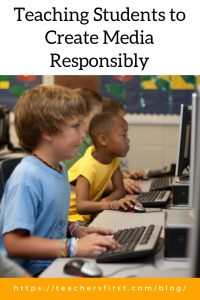 Today, teaching students to create media is not enough. Students must learn to create media responsibly. What does it mean to create media responsibly? According to Common Sense Media, teaching media literacy helps students to “Create media responsibly (by) Recognizing your own point of view, saying what you want to say how you want to say it, and understanding that your messages have an impact is key to effective communication.”
Today, teaching students to create media is not enough. Students must learn to create media responsibly. What does it mean to create media responsibly? According to Common Sense Media, teaching media literacy helps students to “Create media responsibly (by) Recognizing your own point of view, saying what you want to say how you want to say it, and understanding that your messages have an impact is key to effective communication.”
In our increasingly global world, communication through the creation of media is a necessary skill. Students consume media on a daily basis. They should also be encouraged to create it. There are many lesson plans available for teachers to assist their students in learning to create media responsibly. There are topic-specific lessons available for many topics like civics, PSAs, real word heroes, sustainable development goals, journalism, design thinking, creating videos, and connecting to a global audience. To ensure that students are creating media responsibly, they should use a tool like Kathy Schrock’s Copyright and Fair Use Guidelines for School Projects to ensure that they are creating media without plagiarising. Teachers should analyze and evaluate student-created media using a process like this one from Mediasmarts.
There are many tools available for students to create media. Use the TeachersFirst classroom resources search tool to find specific tools. Students can create videos using Animoto, Flipgrid, and Toontastic. Create audio projects with Audacity, Podbean, Storycorps, and Chatterpix Kids. They can create mixed media projects using Sway, Kapwing, Animaker, and Wakelet. Create to Learn Online is an overall media educational media creation site that offers teaching resources, an online learning community for teachers, examples of student work, as well as links to free and low-cost digital tools to create nine types of media.
Overall students must be allowed to create media to learn to create media responsibly. What better place to learn that than in your classroom?!? Be your students’ guide in their journey to becoming media literate responsible consumers and creators of media. Be sure to check out the previous posts in this media literacy blog series!


One thought on “Teaching Students to Create Media Responsibly”